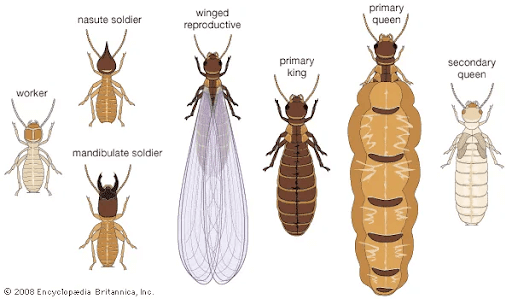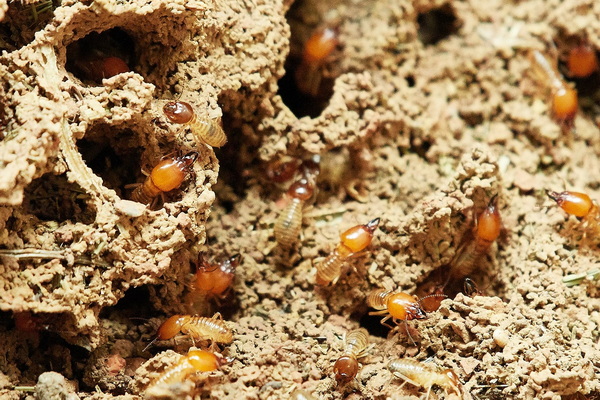
There are over 2,500 known species of termites found globally, but only four are considered a problem here in Missouri. All four of these species are subterranean, meaning they live in soil or in wood that is in contact with soil. Subterranean termites are a serious threat to the value of your home. They construct unique tunnels that resemble and are commonly referred to as mud tubes. They have saw-toothed teeth that they use to gnaw off tiny pieces of wood, one by one, around the clock, every day of the week. A building’s structural integrity will deteriorate severely over time, and may even collapse entirely.
Termites are naturally good for the environment because they recycle nutrients lost in the decomposition of dead wood and other cellulose materials, but they are major nuisance pests in human-inhabited settings. In the United States alone, it costs over $4.5 billion a year to deal with termite infestations and fix the damage they create.
Termite ID
Over the past 120 million years, termites have occupied every continent except Antarctica. If you are unlucky enough to discover this bug in your home, do not delay in taking action. It’s generally not wise to try to DYI a termite infestation. Contact a registered pest control expert who can effectively treat the problem before it becomes unmanageable. There are three main types of subterranean termites which can be readily identified by a trained professional.
Termites and other social insects form enormous colonies where members work together in different ‘castes’ to maintain the colony’s survival. Eggs, larvae, workers, soldiers, nymphs, and reproductives are all castes of termites. The king, the queen, and the alates make up the reproductive caste. The queen is much larger than the king, as is the case with many other types of social insects. Alates are commonly referred to as swarmers. Their lengthy, nearly black bodies contrast with their nearly transparent, slightly milky-colored wings. Their bodies range from a quarter to half an inch in length, and their wings may or may not have a few tiny hairs. Swarmers are most common from late spring through early October. Soldiers and laborers are not equipped with wings. The length of a worker is no more than a quarter of an inch, and their bodies are a pale yellow. Soldiers have massive, frightening mandibles to help defend the nest from invaders, while workers have smaller jaws to help with chewing wood and moving goods. They feature large, rectangular bodies and flat, rectangular heads. The heads of workers are a delicate cream tint, while those of soldiers are a darker brown.
Alates, which range in color from shiny brownish to black, are born in fully developed colonies and emerge at specific times of the year to disperse. They are frequently mistaken for ant swarms, but can be differentiated with relative ease. Both species have two pairs of wings. Termite wings are uniform in size, while swarming ants have larger wings in the front than in the back. Termite antennae are straight while ants have elbowed antennae. Termite wings are also much longer than flying ants, nearly twice as long as their body. Termite swarmers molt their wings and form mating pairs after leaving the colony. Each couple establishes a new colony by building a sheltered underground chamber near a supply of wood or other food. This cell is the starting point for reproduction and the formation of a new colony.
Identifying a termite infestation
Infestations of subterranean termites typically begin in the soil around and beneath a home. Sometimes they will construct shelter tubes (mud tubes) from the earth, through the foundation, and into the structural timber if the dirt is not in direct touch with the wood. It is also possible for them to get access through openings in the slab provided by pipes or wires.
Over the course of a few months, termites may cause a lot of damage to a building. Since they prefer to stay hidden, they can be hard to spot without the proper training. Infested wood may appear unharmed on the surface, but the underlying structure may be rife with galleries.
Examination for Termites
- Check the outside of the house for mud tubes. Mud tubes resemble lengthy tunnels constructed from wood and mud.
- Tap on home furniture constructed of wood. If it sounds hollow then a more thorough inspection is necessary.
- Check for changes in wood color or the formation of blisters on the surface.
- Termite feces resembles a small pile of very fine sawdust. These small piles in areas where there should be no sawdust are a visible sign that termites may be present.
- Molting alates discard their wings and you will often see them lying near doors, windowsills or on the ground.
Any of these symptoms suggest an infestation is present. Preserve your home’s value and structural integrity and get in touch with a pest control company right away.
Why choose SetGo?
We are familiar with all aspects of termite management, from pre-construction to the treatment of historically significant buildings. We offer pre-sale examinations for local realtors at affordable prices and can provide efficient extermination and prevention for any homeowner. To schedule your no-cost assessment, contact us now.

